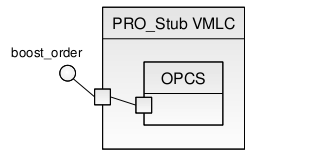The Distributed Toy Example: Concurrency View
In this section, we apply the model transformation to the Distributed Toy Example.
Node N1, Partition P1: POS, GNC, TMTC, Stub
The generation of POS, GNC and TMTC
has already been discussed in the Partitioned Toy Example:
Concurrency View section. Here we turn our attention
only to the generation of the stub called for in the distributed
transformation of the Toy Example model.
The generation of a stub is required by the calling VMLC involved in a distributed communication and provided by the corresponding remote VMLC. In the case of the Distributed Toy Example the Boost_Order operation becomes distributed. The stub VMLC is created to be the access point to the network communication middleware: to limit the overhead induced on the timing and sizing behaviour of the system at run time, the PI of the stub VMLC are always immediate.

Figure 8.11: The stub VMLC for a PRO VMLC
Node N2, Partitions P2 and P3: PRO instances, Skeleton
We have already discussed the generation of the PRO APLC. We now show the generation of its skeleton components.
Model transformation generates one partition with one VMLC that acts as a skeleton, that is to say, as the local proxy of the remote caller of the designated component. The partition that contains the skeleton VMLC is attributed the same criticality level as the partition of residence of the remote caller. Generating a distinct partition on the destination node eases the representation of the criticality attribute of the calling component on the remote node. Simple optimization permits to merge that partition with any other partition on the target node which has equivalent criticality attributes. In this particular case, model transformation generates only one skeleton partition since one is the remote calling partition. The skeleton VMLC is threaded and typed sporadic; it provides an elementary PI which is invoked by the network communication middleware, and an elementary RI connected to the target elementary PI of the callee.

Figure 8.12: The skeleton VMLC for a TMTC VMLC
Node N3, Partition P4: PRO instance, Skeleton
This treatment of this case produced a VMLC similar to the one discussed in the Partitioned Toy Example: Concurrency View section.